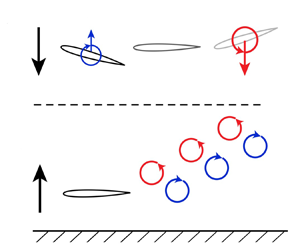Article contents
Revealing the mechanism and scaling laws behind equilibrium altitudes of near-ground pitching hydrofoils
Published online by Cambridge University Press: 28 December 2023
Abstract

A classic lift decomposition (Von Kármán & Sears, J. Aeronaut. Sci., vol. 5, 1938, pp. 379–390) is conducted on potential flow simulations of a near-ground pitching hydrofoil. It is discovered that previously observed stable and unstable equilibrium altitudes are generated by a balance between positive wake-induced lift and negative quasi-steady lift while the added mass lift does not play a role. Using both simulations and experiments, detailed analyses of each lift component's near-ground behaviour provide further physical insights. When applied to three-dimensional pitching hydrofoils the lift decomposition reveals that the disappearance of equilibrium altitudes for  ${A{\kern-4pt}R}\ {\rm (aspect\ ratio)} <1.5$ occurs due to the magnitude of the quasi-steady lift outweighing the magnitude of the wake-induced lift at all ground distances. Scaling laws for the quasi-steady lift, wake-induced lift and the stable equilibrium altitude are discovered. A simple scaling law for the lift of a steady foil in ground effect is derived. This scaling shows that both circulation enhancement and the velocity induced at a foil's leading edge by the bound vortex of its ground image foil are the essential physics to understand steady ground effect. The scaling laws for unsteady pitching foils can predict the equilibrium altitude to within
${A{\kern-4pt}R}\ {\rm (aspect\ ratio)} <1.5$ occurs due to the magnitude of the quasi-steady lift outweighing the magnitude of the wake-induced lift at all ground distances. Scaling laws for the quasi-steady lift, wake-induced lift and the stable equilibrium altitude are discovered. A simple scaling law for the lift of a steady foil in ground effect is derived. This scaling shows that both circulation enhancement and the velocity induced at a foil's leading edge by the bound vortex of its ground image foil are the essential physics to understand steady ground effect. The scaling laws for unsteady pitching foils can predict the equilibrium altitude to within  $20\,\%$ of its value when
$20\,\%$ of its value when  $St\ {\rm (Strouhal\ number)} < 0.45$. For
$St\ {\rm (Strouhal\ number)} < 0.45$. For  $St \ge 0.45$ there is a wake instability effect, not accounted for in the scaling relations, that significantly alters the wake-induced lift. These results not only provide key physical insights and scaling laws for steady and unsteady ground effects, but also for two schooling hydrofoils in a side-by-side formation with an out-of-phase synchronization.
$St \ge 0.45$ there is a wake instability effect, not accounted for in the scaling relations, that significantly alters the wake-induced lift. These results not only provide key physical insights and scaling laws for steady and unsteady ground effects, but also for two schooling hydrofoils in a side-by-side formation with an out-of-phase synchronization.
JFM classification
- Type
- JFM Papers
- Information
- Copyright
- © The Author(s), 2023. Published by Cambridge University Press
References
- 8
- Cited by



